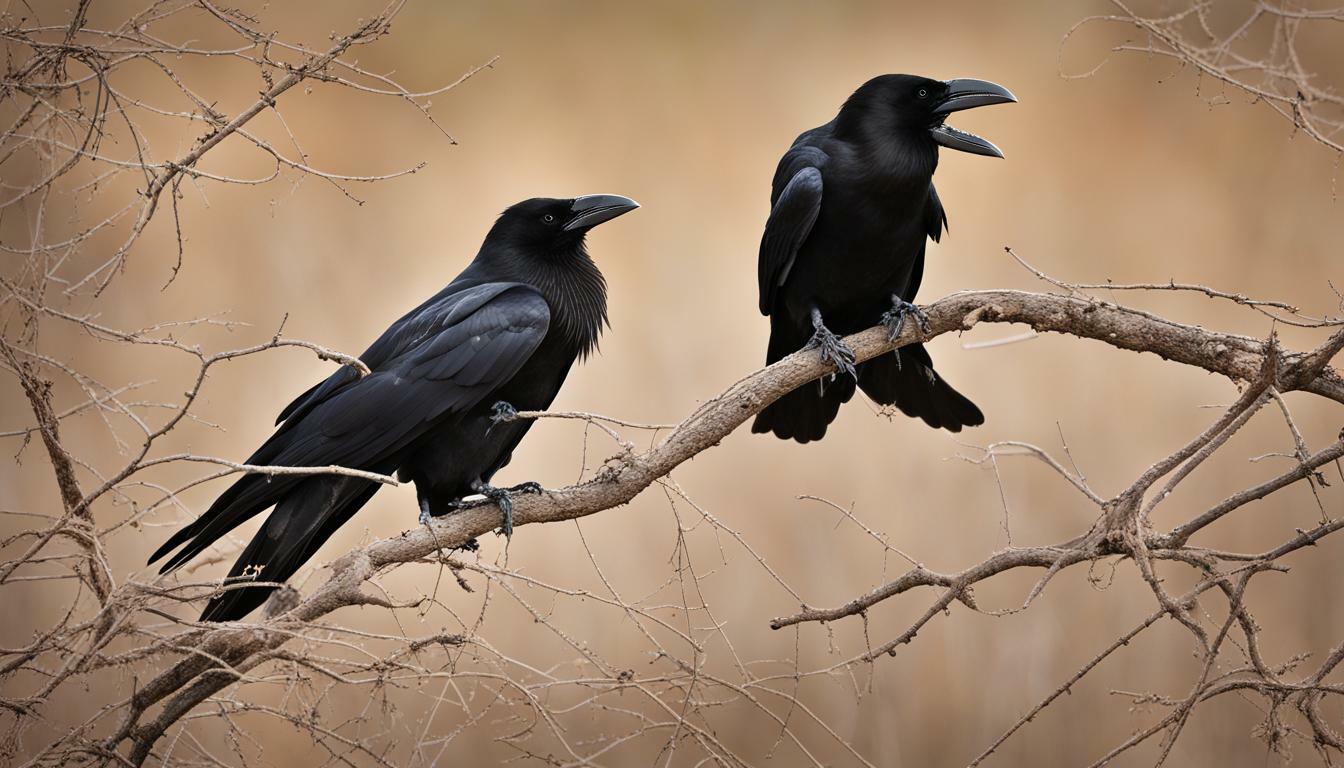If you’ve ever observed a pair of crows flying together or perched side by side, you may wonder if they mate for life. The answer is not so simple, as the mating habits of crows can vary. However, they do display fascinating and complex courtship rituals and establish long-term partnerships.
In this article, we will delve into the topic of crow mating habits and breeding patterns, exploring their courtship rituals, reproductive behavior, pair bonding, and family dynamics. By the end of this article, you will have a better understanding of crow love life.
Key Takeaways
- Crows display intricate courtship rituals and establish long-term partnerships.
- Crows are not strictly monogamous for life, but they do form lasting pair bonds.
- Breeding patterns of crows contribute to their family dynamics, with both parents playing a role in raising the offspring.
Crow Mating Habits and Courtship Rituals
Now that we have established that crows do indeed form lasting partnerships, let’s take a closer look at their mating habits. Crow mating rituals involve a variety of vocalizations and displays that help them establish pair bonds.
Male crows will often court females by offering them food or performing aerial displays. They may also engage in mutual preening or touch bills with their mate. Once a pair bond is established, the crows will engage in reproductive behavior.
Crow reproductive behavior involves the female selecting a nest site and constructing the nest out of twigs and other materials. The female will then lay eggs, usually in the spring, which both parents will take turns incubating. Once the eggs hatch, both parents will help raise the offspring, which will stay with the parents for several months before becoming independent.
It is interesting to note that crows exhibit both monogamous and polygamous behavior, meaning that while they may form a long-term partnership, they may also mate with other crows outside of their pair bond. Overall, crow mating habits and courtship rituals contribute to the complex social dynamics of these intelligent birds.
Lifetime Partnership of Crows
When it comes to the love life of crows, the concept of monogamy and lifetime partnership is a common assumption. While it is true that crows form strong pair bonds, they are not strictly monogamous for life.
Crows are known to engage in extra-pair copulations, which means that they may mate with individuals outside of their pair bond. However, this behavior occurs much less frequently than the forming and maintaining of the initial bond.
Crow pair bonding behavior starts with courtship rituals that involve vocalizations, displays, and the exchange of food. Once a pair bond is established, it can last for several years, if not for the entirety of their lives.
The benefits of these long-term partnerships include a higher success rate for breeding due to the cooperation and support of both parents in raising offspring. Additionally, the social structure within crow families allows for the sharing of resources and protection against predators.
In conclusion, while crows are not strictly monogamous for life, they do form lasting partnerships that contribute to their overall breeding success and family dynamics. Understanding the complexities of crow mating habits and pair bonding behavior sheds light on the fascinating love life of these intelligent birds.
Crow Breeding Patterns and Family Dynamics
When it comes to breeding, crows are known for their unique patterns and family dynamics. They typically mate for life, establishing a strong pair bond that lasts for many years. Once they have found a compatible mate, they will work together to build a nest and prepare for breeding.
The nest-building process can take several weeks and involves a lot of hard work and dedication from both birds. They will carefully select a location for their nest, usually in a tall tree or on a high ledge, and then begin to gather materials to build it. This may include sticks, twigs, grass, and other natural materials.
Once the nest is complete, the female will begin to lay eggs, usually in the early spring. The incubation period lasts for around 18-20 days, during which time the male will bring food to the female to help support her and the developing embryos. Once the eggs hatch, both parents will take on the responsibility of caring for the young.
Crow family dynamics are fascinating to observe. Both parents are highly involved in raising the offspring, with the male playing a particularly important role. He will help to find food, protect the nest, and defend the family against predators. Crows are also known for their social structure, with young birds often staying with their parents for several years and assisting with the care of subsequent broods.
Crow Family Life Cycle
The life cycle of a crow family typically follows a predictable pattern. After hatching, the young birds will spend several weeks in the nest, being cared for by their parents. As they grow older, they will begin to venture out of the nest and learn valuable skills such as feeding, flying, and socializing with other birds.
After a few months, the young birds will become fully independent and leave the nest to start their own lives. They may join flocks of other crows or strike out on their own, searching for a mate and establishing their own territory.
Overall, the breeding patterns and family dynamics of crows offer a fascinating glimpse into the complex social lives of birds. By working together to build nests, care for their young, and protect their families, these intelligent and resourceful birds have developed a way of life that is truly unique.
Conclusion
So, do crows mate for life? While they do form long-lasting partnerships, they are not strictly monogamous for life. As we’ve learned, crow mating habits involve courtship rituals, vocalizations, and displays that help establish pair bonds. Crow breeding patterns also contribute to their family dynamics, with both parents playing a role in raising offspring.
Understanding the lifetime partnership of crows, their monogamy, and their family dynamics gives us a glimpse into the fascinating love life of these intelligent birds. We hope you gained a deeper appreciation for the complexity of crow mating behavior and breeding patterns. Next time you see a pair of crows together, you’ll know they may very well be partners for life.
Are Penguin Mates as Devoted as Crow Mates?
Penguins and their lifelong bonds are well-known among researchers. However, when comparing their devotion to crow mates, certain differences arise. While penguins remain faithful to their partners through thick and thin, crows are generally more indifferent in their partnerships. Thus, whilst both species exhibit unique bonding behaviors, penguins truly shine in their unwavering loyalty to their mates.
FAQ
Q: Do crows mate for life?
A: No, crows do not mate for life. While they form long-lasting partnerships, they are not strictly monogamous and may have multiple mates throughout their lifetime.
Q: What are crow mating habits and courtship rituals?
A: Crow mating habits involve courtship rituals such as vocalizations and displays. They establish pair bonds through these rituals to prepare for breeding.
Q: How do crows form lifetime partnerships?
A: Crows form lasting partnerships through pair bonding. While they may have multiple mates throughout their lifetime, they maintain strong relationships with their partners.
Q: What are crow breeding patterns and family dynamics?
A: Crow breeding patterns involve nest-building, egg-laying, incubation, and rearing of young. Both parents play a role in raising the offspring, and crow families have a social structure.











